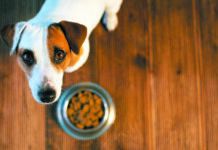You love your dog and don’t mind giving him table scraps here and there. But it has gotten to the point that every time you sit down to eat, he’s there — begging, nudging, drooling, and beseeching with wide eyes for some of your meal. How has something that you thought was cute and tried to be nice about — and loving about — turned into such a persistent, annoying problem?
For one thing, dogs are opportunists. If you give them an “in,” they’re going to take it. And when you “forget” to provide that “in,” they’re going to use all their beguiling — and annoying — ways to take it, anyway.
Add to that the fact that dogs don’t have a sense for what’s appropriate. “Sometimes” just doesn’t compute. They do much better with “all or nothing.” In fact, consistency, even if it’s consistency your pet wouldn’t choose for himself, makes him feel secure.
So you have to decide whether you’re going to give your dog some food from your own plate every time you sit down to eat, or whether you’re never going to. But how do you switch to “never” if your dog expects to be fed at the table with the rest of the family?
Going cold turkey
It will not work to gradually ease your dog out of making his way to the table for scraps. Sometimes yes, sometimes no, will just keep him coming. If it’s worth a try, he’ll put in the energy to beg.
Instead, you’re going to have to put a cold stop to the behavior. At first your dog will ramp up his efforts. “Gee, it has always worked before — I’ll have to try harder. My human is slipping.” But within a few days he’ll give up. You might feel a little bad, but if you give him plenty of “we” time with good walks and games and lots of brushing and other attention, he’ll be happy — and so will you.
If you are okay with your dog coming to the table for a nosh while you eat, just keep in mind that treats shouldn’t make up more than 10 percent of a dog’s calories. Ninety percent of them should come from kibble or wet food that is nutritionally balanced for his needs. That means the morsels you give should be very small. In addition, if your pet has an illness like heart or kidney disease that requires adherence to a therapeutic diet, consuming table food probably isn’t the best idea.





